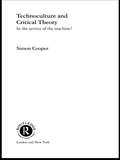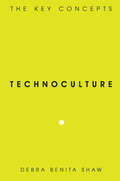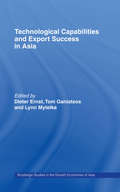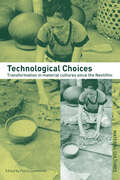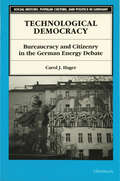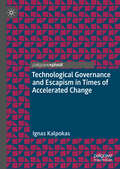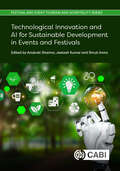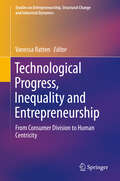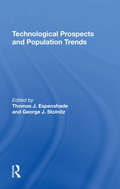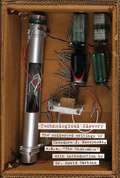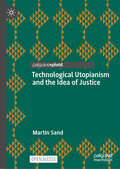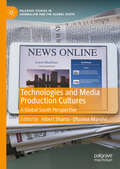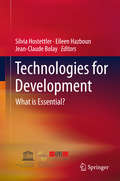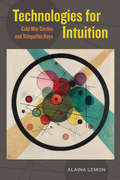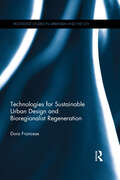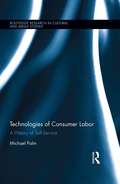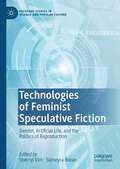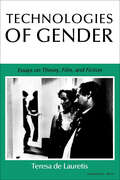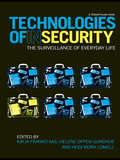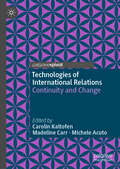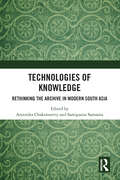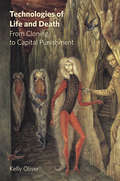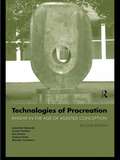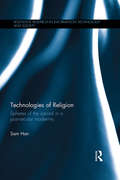- Table View
- List View
Technoculture and Critical Theory: In the Service of the Machine? (Routledge Studies in Science, Technology and Society #5)
by Simon CooperThe author explores the work of major thinkers and cultural movements that have grappled with the complex relationship between technology, politics and culture. Subjects such as the Internet, cloning, warfare, fascism and Virtual Reality are placed within a broad theoretical context which explores how humanity might, through technology, establish a more ethical relationship with the world.Examining the philosophy of writers such as Heidegger, Benjamin, Lyotard, Virilio, and Zizek, and cultural movements such as Italian Futurism, this book marks a timely intervention in critical theory debates. The broad scope of the book will be of vital interest to those in the fields of philosophy, critical theory, cultural studies, politics and communications.
Technoculture: The Key Concepts (The\key Concepts Ser.)
by Debra Benita ShawWe live in a world where science and technology shape the global economy and everyday culture, where new biotechnologies are changing what we eat and how we can reproduce, and where email, mobiles and the internet have revolutionised the ways we communicate with each other and engage with the world outside us.Technoculture: The Key Concepts explores the power of scientific ideas, their impact on how we understand the natural world and how successive technological developments have influenced our attitudes to work, art, space, language and the human body. Throughout, the lively discussion of ideas is illustrated with provocative case studies - from biotech foods to life-support systems, from the Walkman and iPod to sex and cloning, from video games to military hardware. Designed to be both provocative and instructive, Technoculture: The Key Concepts outlines the place of science and technology in today's culture.
Technological Capabilities and Export Success in Asia (Routledge Studies in the Growth Economies of Asia)
by Dieter Ernst Tom Ganiatsos Lynn MytelkaWhat accounts for export success? A team of international contributors show that learning and capability formation are critical to sustain competitiveness. Through a series of case studies of firms in the textile and garment and electronics industries of five Asian economies - Korea, Taiwan, Thailand, Indonesia and Vietnam - Technological Capabilities and Export Success in Asia demonstrates that cheap labour, combined with currency devaluation, is no longer sufficient for export success.
Technological Choices: Transformation in Material Cultures Since the Neolithic (Material Cultures)
by Pierre LemonnierTechnological Choices applies the critical tools of archaeology to the subject of technology and its impact on humankind throughout the ages. An examination of the challenges technological innovations present to various cultures, Technological Choices asserts that in any society, such choices are made on the basis of cultural values and social relations, rather than on the inherent benefits in technology itself. Of course, this revolutionary viewpoint has critical implications for contemporary Western societies. Based on case studies covering a wide range of chronologies and geographies, Technological Choices moves rapidly from Neolithic Europe to the modern industrial age, stopping on the way to examine the tribes of Papua, New Guinea, rural Indian and North African societies as well as several European peasant communities. The techniques studied range from the manufacture of stone implements to the development of high-tech transportation devices. With its breadth of subject matter and multidisciplinary approach, Technological Choices offers new insight into the interrelationship between technology and society. Also unprecedented is the book's emphasis on the functional aspects of material culture.
Technological Democracy: Bureaucracy and Citizenry in the German Energy Debate (Social History, Popular Culture, And Politics In Germany)
by Carol J. HagerWhat are the prospects for democratic participation in the modern technological state? Is technology a force of emancipation or enslavement? Intellectuals such as Max Weber have prophesied that complex issues would ultimately be decided by technical experts instead of by those who were affected or their political representatives—and that politics would give way to technocracy. Technological Democracy explores the connection between environmental and democratizing concerns in Germany, to see what answers environmental groups might provide to the question of the citizen's role in a technological society. The volume explores the ways in which lay citizens can participate in policy decisions of a technical nature, and whether in doing so they can repoliticize and democratize those policy areas that have become the territory of experts. Technological Democracy will be of interest to scholars and students in German history, political science, and sociology.
Technological Governance and Escapism in Times of Accelerated Change (Information Technology and Global Governance)
by Ignas KalpokasThis book examines escapist coping strategies brought about by the pace, breadth and governance of technological change. It argues that escapism manifests in various forms, ranging from nostalgia for a fantasised past of unhindered reason and agency, to progressive visions of societal and political improvement, and greater empowerment. Drawing on post-humanist theory and critical disability studies, the book also assesses how escapism should not be viewed as an unavoidable reaction to technological change, and develops a model for an ethically equitable relationship between humans and technology. It will appeal to all those interested in governance and politics, media and communication studies, technology studies, and philosophy.
Technological Innovation and AI for Sustainable Development in Events and Festivals (Festival and Event Tourism and Hospitality Series)
by Anukrati Sharma Jeetesh Kumar Shruti AroraFrom sustainable event planning to the influence of VR, AI, and mobile applications on tourist behaviour, this book explores the dynamic landscape where innovation meets tradition. It studies the intersection of green technologies, sustainable infrastructure, and the delicate balance between cutting-edge tools and the intrinsic emotional aspects of human engagement. Aligned with the United Nations' 17 Sustainable Development Goals, the book highlights AI's potential to drive meaningful contributions to a sustainable future. It anticipates the imminent transformation of festivals and events through technological innovation and AI implementation. It will allow the reader to gain insights into how automation streamlines logistics, optimizes marketing efforts, and enhances the overall attendee experience. The book offers readers: · A cutting-edge exploration of the transformative impact of technologies and artificial intelligence on the events and tourism industries. · Oversight of how new technology can align with the United Nations' 17 Sustainable Development Goals - readers can anticipate insights into how AI can contribute meaningfully to understanding and addressing pressing global challenges. · Practical insights for stakeholders including actionable insights that go beyond theory. It will be an essential reference for academic researchers and practitioners within events and tourism management.
Technological Progress, Inequality and Entrepreneurship: From Consumer Division to Human Centricity (Studies on Entrepreneurship, Structural Change and Industrial Dynamics)
by Vanessa RattenAlthough there have been considerable technological advances over the past decade, particularly in terms of mobile applications, much remains unknown about their effect on societal progress. This book focuses on how inequality and entrepreneurship are both by-products of technological change. The book provides insights into how society has shifted from consumer division to human centricity, and helps readers gain a better understanding of the positive and negative effects of entrepreneurship.
Technological Prospects And Population Trends
by Thomas J Espenshade George J StolnitzThe world’s population is now estimated at over 5 billion, and projections call for a continued high growth rate, predominantly in the less-developed countries. Concern over the consequences of this situation has led to numerous public policy debates, and the complex interrelationships between population and technology have become an important new topic in demographic research. The papers in this book are based on a symposium entitled “Technological Prospects and Population Trends†arranged for the 150th National Annual Meeting of the American Association for the Advancement of Science in New York City in May 1984. The book focuses on clarification of the impact that technological development and population change have on one another. For instance, how may population and related socioeconomic trends be conditioned by expected or foreseeable technological changes? What is the impact of population on technology in both the developed and newly industrializing areas of the world? Linking demography with developments in the major areas of agriculture, education, contraception, longevity, and health care, the distinguished contributors offer diverse yet integrated perspectives on what is fast becoming one of the major issues of our time.
Technological Slavery
by Theodore J. Kaczynski David Skrbina"Like many of my colleagues, I felt that I could easily have been the Unabomber's next target. He is clearly a Luddite, but simply saying this does not dismiss his argument. . . . As difficult as it is for me to acknowledge, I saw some merit in the reasoning in [Kaczynski's writing]. I started showing friends the Kaczynski quote from Ray Kurzweil's The Age of Spiritual Machines; I would hand them Kurzweil's book, let them read the quote, and then watch their reaction as they discovered who had written it." -- Bill Joy, founder of Sun Microsystems, in "Why the Future Doesn't Need Us," Wired magazineTheodore J. Kaczynski has been convicted for illegally transporting, mailing, and using bombs, resulting in the deaths of three people. He is now serving a life sentence in the supermax prison in Florence, Colorado.The ideas and views expressed by Kaczynski before and after his capture raise crucial issues concerning the evolution and future of our society. For the first time, the reader will have access to an uncensored personal account of his anti-technology philosophy, which goes far beyond Unabomber pop culture mythology.Feral House does not support or justify Kaczynski's crimes, nor does the author receive royalties or compensation for this book. It is this publisher's mission, as well as a foundation of the First Amendment, to allow the reader the ability to discern the value of any document.David Skrbina, who wrote the introduction, teaches philosophy at the University of Michigan, Dearborn.
Technological Utopianism and the Idea of Justice
by Martin SandThis open access book advances a modest defence of technological utopias. While technological utopianism is not devoid of risks and elitism, their benefits should not be discounted in an overall assessment. Rather than rejecting them based on a too narrow definition of utopianism, we must acknowledge their potential to exceed the individualist vs. collectivist dichotomy ascribed to traditional utopias. The author argues, with reference to Rawls’ idea of the basic structure that technological utopias challenge our understanding of the scope and location of justice and, thereby, advance the idea of justice. The book critically reviews the most recent literature in political philosophy, where utopias are understood as ideal theories of justice and sides with recent contributions to Utopian Studies, where utopias’ potential to estrange from the present and galvanize action are underscored.
Technologie, sozialer Wandel und menschliches Verhalten: Einfluss für Wirkung
by Cornelia C. WaltherDieses Buch befasst sich mit dem organischen Kontinuum, das Individuen, Gemeinschaften und die Gesellschaft miteinander verbindet. Ein Überblick über Aspirationelle Algorithmen (AA) und Wertvolle Werkzeuge (WW) illustriert den möglichen Nutzen von Technologie, um einen bewussten Übergang einzuleiten, vom KI-Kult zur Kultivierung von Höherer Humanität (HH). Die menschliche Einstellung, die hinter dem Design und der Nutzung von Technologie steht, bestimmt die Ergebnisse der Technologie. Wenn das angestrebte Ergebnis das Gemeinwohl ist, dann muss das vorausgehende menschliche Streben auf dieses Ziel ausgerichtet sein. Nur eine Technologie, die mit dem Ziel konzipiert wurde, eine Gesellschaft zu schaffen die den Einzelnen zur Entfaltung seines Potenzials befähigt, wirkt sich positiv auf das Gemeinwohl aus. Angesichts des ständigen Wechselspiels zwischen den vier Dimensionen der menschlichen Existenz - Seele, Herz, Verstand, Körper -, die sich in Form von Bestrebungen, Emotionen, Gedanken und Empfindungen ausdrücken, wird deutlich, wie Technologie dazu dienen kann, den Einzelnen systematisch von der Inspiration zum Wunsch, von der Information zur Zündung einer spürbaren Veränderung zu führen. Dieses Buch erklärt den Übergang entlang einer multidimensionalen Einfluss Skala. Zwei sich gegenseitig beeinflussende Dynamiken werden analysiert: erstens der Einfluss von Werten und Bestrebungen auf die Wirkung von Technologie und zweitens der Einfluss von Technologie auf die Einstellung und das Handeln der Nutzer. Beide Ansätze zielen darauf ab, zu bewerten wie Hard- und Software einem Maximum an Menschen zu einem sinnvollen, glücklichen Leben verhelfen können.
Technologies and Media Production Cultures: A Global South Perspective (Palgrave Studies in Journalism and the Global South)
by Ufuoma Akpojivi Albert SharraThis volume delves into the intricate relationship between technology and media production, emphasizing its influence across political, socio-economic, and cultural contexts. By 2010, the integration of computing and automated systems had already begun revolutionizing media production, prompting traditional outlets to embrace a 'digital first' approach. Concepts like dual-management processes and the fusion of traditional and digital systems have emerged, challenging conventional norms. What sets this transformation apart is the gradual replacement of human decision-making with communicative artificial intelligence and automation. Technology now plays a central role in producing and distributing news and Ads, fundamentally altering the media landscape. However, there has been limited exploration of the broader implications of these advancements, particularly from the perspective of the Global South. This edited volume seeks to address this gap by featuring papers that examine how technology has reshaped newsroom and advertorial processes in countries like Malawi, South Africa, and Nigeria. Through a collection of insightful essays, readers are invited to explore the transformative power of technology in media production, packaging, and distribution systems. From digital innovations to traditional media adaptations, this volume offers a comprehensive understanding of the evolving media landscape in the age of technology.
Technologies for Development
by Eileen Hazboun Jean-Claude Bolay Silvia HostettlerThe book presents case studies from Africa, Asia and Latin America addressing global development issues in the fields of health, energy, ICT and urbanism in an interdisciplinary way. The book illustrates key issues at the interface of technology, human, social, and economic development. Bringing together the best papers of the 2014 EPFL-UNESCO Conference on Technologies for Development, this book explores innovative technologies in the global South. It will be a valuable reference for researchers from engineering, natural sciences, information management, quantitative social sciences, and business faculties, as well as for development practitioners and policy makers. It shows the development potential of technologies, and discusses successful processes to develop and deploy them, as well how to evaluate their impact. The introduction to the book begins with a reflection on key issues regarding technologies for development. The following four sections focus on; (i) Innovative Technologies for Development, (ii) Open Source-Open Access-Open Innovation, (iii) Medical Technologies for the Global South, and (iv) Impact Assessment of Technologies for Development. Individual chapters explore issues such as a need for solid standards for newly developed technologies, how to successfully up-scale technology to a larger region, and how to involve private industry in the development of a technology.
Technologies for Intuition: Cold War Circles and Telepathic Rays
by Alaina LemonSince the Cold War, Americans and Russians have together cultivated fascination with the workings and failures of communicative channels. Each accuses the other of media jamming and propaganda, and each proclaims its own communication practices better for expression and creativity. Technologies for Intuition theorizes phaticity—the processes by which people make, check, discern, or describe channels and contacts, judging them weak or strong, blocked or open. This historical ethnography of intuition juxtaposes telepathy experiments and theatrical empathy drills, passing through settings where media and performance professionals encounter neophytes, where locals open channels with foreigners, and where skeptics of contact debate naifs. Tacking across geopolitical borders, the book demonstrates how contact and channel shift in significance over time, through events and political relations, in social conflict, and in conversation. The author suggests that Cold War preoccupations and strategies have marked theoretical models of communication and mediation, even while infusing everyday, practical technologies for intuition.
Technologies for Sustainable Urban Design and Bioregionalist Regeneration (Routledge Studies in Urbanism and the City)
by Dora FranceseThis book explores the role of technology in ecological urban design and regeneration. Part I provides theoretical and methodological insights into technological approaches that offer optimum respect to existing cultural and natural environments, while offering minimum impact and carbon footprint. Parts II and III provide contextualised examples that demonstrate the use, or proposal of, sustainable technologies and solutions for regenerating parts of the urban and peri-urban. The case studies offer insights from the Mediterranean and the Middle East in a diverse range of spaces, from central urban squares, oblique cities, urban waterfronts, decaying suburbs, to peri-urban areas such as touristic waterfronts, former industrial areas, hyper-commercial areas, humid zones and parks.
Technologies of Consumer Labor: A History of Self-Service (Routledge Research in Cultural and Media Studies)
by Michael PalmThis book documents and examines the history of technology used by consumers to serve oneself. The telephone’s development as a self-service technology functions as the narrative spine, beginning with the advent of rotary dialing eliminating most operator services and transforming every local connection into an instance of self-service. Today, nearly a century later, consumers manipulate 0-9 keypads on a plethora of digital machines. Throughout the book Palm employs a combination of historical, political-economic and cultural analysis to describe how the telephone keypad was absorbed into business models across media, retail and financial industries, as the interface on everyday machines including the ATM, cell phone and debit card reader. He argues that the naturalization of self-service telephony shaped consumers’ attitudes and expectations about digital technology.
Technologies of Feminist Speculative Fiction: Gender, Artificial Life, and the Politics of Reproduction (Palgrave Studies in Science and Popular Culture)
by Sherryl Vint Sümeyra BuranTechnologies of Feminist Speculative Fiction: Gender, Artificial Life, and the Politics of Reproduction explores how much technology has reshaped feminist conversations in the decades since Donna Haraway’s influential “Cyborg Manifesto” was published. With sections exploring reproductive technologies, new ways of imagining femininity and motherhood via artificial means, queer readings of gender as a social technology, and posthuman visions of a world beyond gender, this book demonstrates how feminist speculative fiction offers an urgently needed response to the intersections of women’s bodies and technology. This collection brings together authors from Europe, Japan, the US and the UK to consider speculative films and texts, reproductive technologies and food futures, and opportunities to rethink family, aging, gender and sexuality, and community through feminist speculative fiction, a social technology for building better futures.
Technologies of Gender: Essays On Theory, Film, And Fiction
by Teresa de de Lauretis"Technologies of Gender builds a bridge between the fashionable orthodoxies of academic theory (Lacan, Foucault, Derrida, et al.) and the frequently-marginalized contributions of feminist theory.... In sum, de Lauretis has written a book that should be required reading for every feminist in need of theoretical ammunition--and for every theorist in need of feminist enlightenment." --B. Ruby Rich"... sets philosophical ideas humming.... she has much to say." --Cineaste"I can think of no other work that pushes the debate on the female subject forward with such passion and intellectual rigor." --SubStanceThis book addresses the question of gender in poststructuralist theoretical discourse, postmodern fiction, and women's cinema. It examines the construction of gender both as representation and as self-representation in relation to several kinds of texts and argues that feminism is producing a radical rewriting, as well as a rereading, of the dominant forms of Western culture.
Technologies of InSecurity: The Surveillance of Everyday Life
by Katja Aas Helene Gundhus Heidi LomellTechnologies of Insecurity examines how general social and political concerns about terrorism, crime, migration and globalization are translated into concrete practices of securitisation of everyday life. Who are we afraid of in a globalizing world? How are issues of safety and security constructed and addressed by various local actors and embodied in a variety of surveillance systems? Examining how various forms of contemporary insecurity are translated into, and reduced to, issues of surveillance and social control, this book explores a variety of practical and cultural aspects of technological control, as well as the discourses about safety and security surrounding them. (In)security is a politically and socially constructed phenomenon, with a variety of meanings and modalities. And, exploring the inherent duality and dialectics between our striving for security and the simultaneous production of insecurity, Technologies of Insecurity considers how mundane objects and activities are becoming bearers of risks which need to be neutralised. As ordinary arenas - such as the workplace, the city centre, the football stadium, the airport, and the internet - are imbued with various notions of risk and danger and subject to changing public attitudes and sensibilities, the critical deconstruction of the nexus between everyday surveillance and (in)security pursued here provides important new insights about how broader political issues are translated into concrete and local practices of social control and exclusion.
Technologies of International Relations: Continuity And Change
by Michele Acuto Carolin Kaltofen Madeline CarrThis book examines the role of technology in the core voices for International Relations theory and how this has shaped the contemporary thinking of ‘IR’ across some of the discipline’s major texts. Through an interview format between different generations of IR scholars, the conversations of the book analyse the relationship between technology and concepts like power, security and global order. They explore to what extent ideas about the role and implications of technology help to understand the way IR has been framed and world politics are conceived of today. This innovative text will appeal to scholars in Politics and International Relations as well as STS, Human Geography and Anthropology.
Technologies of Knowledge: Rethinking the Archive in Modern South Asia
by Samiparna Samanta Aryendra ChakravarttyThis book traces the role of technology in shaping, curating, disseminating, and archiving knowledge and life in South Asia. It focuses on empirical studies of transformative social processes unleashed by technological intervention in colonial and postcolonial contexts, which have changed our everyday lives and created new sites of domination and resistance, and new archives of history.Unraveling technology as an indicator of South Asia’s encounter with modernity, the chapters in the volume interrogate how technology was witnessed in the production of culture, historicizing and preserving the past, and establishing claims to heritage and history. In addition to examining the critical role of creative and commercial networks in establishing communities, the volume also scans the significant contribution of technology as a mechanism of social control. It highlights the pervasive nature of discourse that continues to assert its legitimacy, despite significant challenges to its structures of dominance, be it in the case of Bengali women or imperial dreams of curating a rapidly eroding past. In doing so, the volume emphasizes the discursive thoughts and practices that permeate the functioning of an empire and a postcolonial nation-state through narratives of resilience, appropriation, silences, and dissent.This volume will be of great interest to scholars and researchers of science and technology studies, digital humanities, South Asian studies, modern history, colonialism, and post-independence India.
Technologies of Life and Death: From Cloning to Capital Punishment
by Kelly OliverThe central aim of this book is to approach contemporary problems raised by technologies of life and death as ethical issues that call for a more nuanced approach than mainstream philosophy can provide. To do so, it draws on the recently published seminars of Jacques Derrida to analyze the extremes of birth and dying insofar as they are mediated by technologies of life and death. With an eye to reproductive technologies, it shows how a deconstructive approach can change the very terms of contemporary debates over technologies of life and death, from cloning to surrogate motherhood to capital punishment, particularly insofar as most current discussions assume some notion of a liberal individual.The ethical stakes in these debates are never far from political concerns such as enfranchisement, citizenship, oppression, racism, sexism, and the public policies that normalize them. Technologies of Life and Death thus provides pointers for rethinking dominant philosophical and popular assumptions about nature and nurture,chance and necessity, masculine and feminine, human and animal, and what it means to be a mother or a father. In part, the book seeks to disarticulate a tension between ethics and politics that runs through these issues in order to suggest a more ethical politics by turning the force of sovereign violence back against itself. In the end, it proposes that deconstructive ethics with a psychoanalytic supplement can provide a corrective for moral codes and political clichés that turn us into mere answering machines.
Technologies of Procreation: Kinship in the Age of Assisted Conception
by Sarah Franklin Marilyn Strathern Jeanette Edwards Eric Hirsch Frances PriceTechnologies of Procreation bridges the gap between medical technology and cultural values. It looks at the ways in which the 'technologies of procreation' affect society from an anthropological perspective.
Technologies of Religion: Spheres of the Sacred in a Post-secular Modernity (Routledge Research in Information Technology and Society)
by Sam HanBringing together empirical cultural and media studies of religion and critical social theory, Technologies of Religion: Spheres of the sacred in a post-secular modernity investigates powerful entanglement of religion and new media technologies taking place today, taking stock of the repercussions of digital technology and culture on various aspects of religious life and contemporary culture more broadly. Making the argument that religion and new media technologies come together to create "spheres"—environments produced by an architecture of digital technologies of all sorts, from projection screens to social networking sites, the book suggests that prior social scientific conceptions of religious worship, participation, community and membership are being recast. Using the case of the strain of American Christianity called "multi-site," an emergent and growing church-model that has begun to win favor largely among Protestants in the last decade, the book details and examines the way in which this new mode of religiosity bridges the realms of the technological and the physical. Lastly, the book situates and contextualizes these developments within the larger theoretical concerns regarding the place of religion in contemporary capitalism. Technologies of Religion: Spheres of the sacred in a post-secular modernity offers an important contribution to the study of religion, media, technology and culture in a post-secular world.
